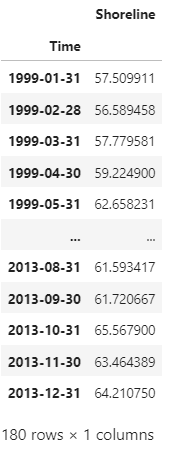This repo hosts a Time Series modeling for prediction of the Tairua Beach (located in New Zealand) shoreline.
The idea for this work stems from a modeling competition (The M4 Competition) where you can find more about in the paper by Makridakis et al. found here.
For more details on the modeling, please refer to the Kaggle Kernel.
The dataset in this study is the monthly records of the beach shoreline from a datum. The data are split into two part.
Training data: which covers a 15-year range (1999 - 2013, inclusive) of the records. This is used to build and calibrate the Time Series model. Next, the model is used to make predictions for the next 3 years and these are compared with Test data (True observations).
Below is a sneak peek at the Training data.
Test data: aka True observations this covers the 3-year range (2014 - 2016, inclusive).
Below is the whole Test data.
Several models have been built which include:
As seen in the below plot, SARIMA model has the best performance compared to others. This model is next used to make predictions.
The plot below, shows the predictions from SARIMA model and compares it with True observations.
Obviously, forecasts are close to True observations so that the lines are not practically distinguishable.
- Several models including (
Adjusted naive,ETS (AAM),ARIMA,SARIMA,RandomForest) were built and their performances were evaluated using the 15-year data (1999 - 2013, inclusive) of whichSARIMAmodel came out as the winner. SARIMAmodel was used to make predictions for the next 3 years (2014 - 2016, inclusive) where predicted values were compared with the test data (true observations). Results show that the predictions are significantly close to the true observations of those 3 years.- There is always room for improvement in this analysis and while building a prefect model is not the intention of this work the main goal is to follow a solid workflow in building a Time-Series model.



